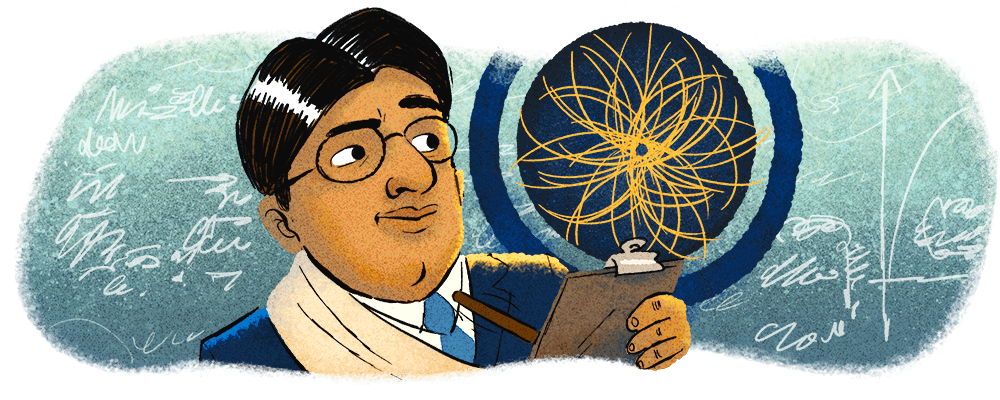Celebrating Satyendra Nath Bose : Google Doodle celebrates Indian physicist and mathematician Satyendra Nath Bose
Satyendra Nath Bose FRS(1 January 1894 – 4 February 1974) was an Indian mathematician and physicist specialising in theoretical physics. He is best known for his work on quantum mechanics in the early 1920s, in developing the foundation for Bose statistics and the theory of the Bose condensate. A Fellow of the Royal Society, he was awarded India’s second highest civilian award, the Padma Vibhushan, in 1954 by the Government of India.
The class of particles that obey Bose statistics, bosons, was named after Bose by Paul Dirac.
A polymath, he had a wide range of interests in varied fields, including physics, mathematics, chemistry, biology, mineralogy, philosophy, arts, literature, and music. He served on many research and development committees in sovereign India.
Bose–Einstein Statistics
While presenting a lecture at the University of Dhaka on the theory of radiation and the ultraviolet catastrophe, Bose intended to show his students that the contemporary theory was inadequate, because it predicted results not in accordance with experimental results.
In the process of describing this discrepancy, Bose for the first time took the position that the Maxwell–Boltzmann distribution would not be true for microscopic particles, where fluctuations due to Heisenberg’s uncertainty principle will be significant. Thus he stressed the probability of finding particles in the phase space, each state having volume h3, and discarding the distinct position and momentum of the particles.
https //stockmarketgame.org Login : The Stock Market Game Login for Online Simulation
Bose adapted this lecture into a short article called “Planck’s Law and the Hypothesis of Light Quanta” and sent it to Albert Einstein with the following letter:
Respected Sir, I have ventured to send you the accompanying article for your perusal and opinion. I am anxious to know what you think of it. You will see that I have tried to deduce the coefficient 8π ν2/c3 in Planck’s Law independent of classical electrodynamics, only assuming that the ultimate elementary region in the phase-space has the content h3. I do not know sufficient German to translate the paper. If you think the paper worth publication I shall be grateful if you arrange for its publication in Zeitschrift für Physik. Though a complete stranger to you, I do not feel any hesitation in making such a request. Because we are all your pupils though profiting only by your teachings through your writings. I do not know whether you still remember that somebody from Calcutta asked your permission to translate your papers on Relativity in English. You acceded to the request. The book has since been published. I was the one who translated your paper on Generalised Relativity.
Google Doodle celebrates Indian physicist and mathematician Satyendra Nath Bose
Satyendra Nath Bose, an Indian physicist and mathematician, is the subject of today’s Google Doodle. When he sent Albert Einstein his quantum formulations on this date in 1924 he recognised it as a major discovery in quantum mechanics right then and there.
Academics were the beginning of Bose’s rise to fame. Before leaving for work each day, Bose’s father, who worked as an accountant, would write a problem for him to solve. This discouraged him from becoming interested in math. When he was just 15 years old, Bose enrolled at Calcutta’s Presidency College to study for a bachelor’s degree in science and a master’s degree in applied mathematics at the University of Calcutta. With first-place honours in both of his degrees, he cemented his place as an academic heavyweight.

He began teaching physics at the end of 1917. Planck began experimenting with his own theories while he was teaching postgraduate students Planck’s radiation formula. A report he wrote on his research, Planck’s Law and the Hypothesis of Light Quanta, was published in the prestigious scientific journal The Philosophical Magazine after he submitted it. His research was turned down, much to his dismay. He took a risky step forward and mailed his paper to Albert Einstein right away.
Activate Cash Assistance Card : Login for Cash Assistance program prepaid card
Bose’s formula had a profound impact on Einstein, and he soon applied it to a variety of phenomena. In quantum theory, Bose’s theoretical paper was one of the most important discoveries. The Padma Vibhushan, one of India’s highest civilian honours, was bestowed upon Bose for his contributions to physics. He was also awarded the title of National Professor in India, the country’s highest honour for academics.
The Indian Physical Society, National Institute of Science, Indian Science Congress, and Indian Statistical Institute were all under the leadership of Bose, a true polymath. A member of the Royal Society, he was also an advisor to the Council of Scientific and Industrial Research. In honour of Bose’s legacy, the term “boson” is used to describe any particle that satisfies his statistical requirements. The discovery of the particle accelerator and the God particle are just two examples of his many accomplishments in the field of science.
https //www.formative.com Login : How to login to Formative with Join Code
Please accept my heartfelt gratitude for your contribution to the advancement of science, Satyendra Nath Bose. The quantum mechanics community is still reeling from the impact of your discovery!
Be the first to comment